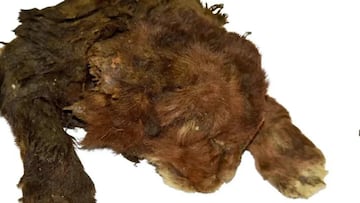Incredible Discovery of a Saber-Toothed Cat Cub in Siberia: Preserved with Skin, Fur, and Claws Intact
The discovery of a three-week-old saber-toothed cat cub offers a unique opportunity to study the extinct mammal.

Once upon a time, in the icy expanses of Siberia, fierce creatures roamed with teeth so long they couldn’t fit in their mouths when closed. These saber-toothed cats were distant relatives of today’s tigers and lions.
Recently, the frozen body of a saber-toothed cat cub was found, and the details of its condition have just been published in the journal Scientific Reports.
The remains of this animal (Homotherium latidens), discovered near the Badyarikha River in northeastern Yakutia, are over 37,000 years old. Remarkably, the cub was in perfect condition, preserved in the Siberian permafrost. This is the first ever discovered mummy of a saber-toothed cat, and according to the study, it died just three weeks after birth.
Experts reported that the body was covered in thick fur, with the face, front limbs, and torso almost entirely intact. The dark brown fur was dense and measured between 0.8 and 1.2 inches. “It’s an incredible feeling to see with your own eyes the appearance of an animal that went extinct so long ago,” said Alexei V. Lopatin, the study’s lead author, to CNN.
Jack Tseng, who studies the anatomy of extinct mammals and was not involved in this discovery, was amazed by the “treasure trove of information that could come from this unique find. It’s rare to find bones from this lineage, let alone associated soft tissue. That makes this discovery even more astounding,” he added.

Great state of preservation
Radiocarbon tests revealed that the cub was at least 35,000 years old. It lived during the late Pleistocene era, and experts noted that its front limbs were in extraordinary condition. Its front paws even retained their claws and oval pads.
The study also highlighted the differences between these ancient cubs and modern lion cubs. The former had darker fur and smaller ears compared to today’s lion cubs. Additionally, the height of the upper lip was more than double that of a lion cub, to cover the long teeth as they grew.
“Never before in the history of palaeontology has it been possible to study the appearance of an extinct mammal with no modern analogs,” the experts detailed. However, due to its early death, the cub had not yet developed the characteristic saber teeth. Compared to lions, these cats had an “unusual” snout shape, and their necks were twice as thick as those of modern lions.
In 2020, scientists unearthed a mummified Homotherium cub—a saber-toothed cat—preserved in ice on Russia’s Badyarikha River. Radiocarbon dating places the cub at 35,000–37,000 years old, making it a rare Late Pleistocene relic and the first of its kind found in Asia. Frozen with… pic.twitter.com/tkM6Oq1zza
— NORTH 02 (@NORTH_o2) November 14, 2024
Related stories
Incomplete pelvic bones, articulated with the femur and tibia, were also found next to the head and the front of the body. They were found wrapped in a piece of ice along with the rest of the body. According to experts, their characteristics are adaptations to cold climates. These animals lived in regions of Eurasia, Africa and the Americas, with different species adapted to each region.
Original article written by Raúl Izquierdo, translated with the assistance of AI and edited by Joe Brennan.


Complete your personal details to comment